1960
1960 A new concept in air vehicles, the flexible wing, was presented to the AOMC Commander under the sponsorship of the Transportation Office. This concept, which consisted of a wing composed of a flexible membrane joined to a vehicle by means of cables or rigid structural members, was a major advance in the field of aerodynamic structures.
January to June 60 During this period, AOMC's aircraft had the second highest amount of flying hours per month of all Army installations worldwide.
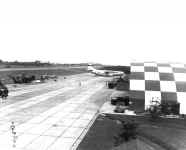
January 60 System development of the MAULER Air Defense System began with the Pomona Division of General Dynamics as prime contractor.
1 January 60 Deliveries of the French-developed SS-10 missile and ground equipment began.
7 January 60 The first MERCURY-REDSTONE booster engine was successfully fired.
8 January 60 An explosion at the Longhorn Ordnance Works in Marshall, Texas, destroyed all propellant mixing capacity for loading motors for certain AOMC missile systems, including the NIKE HERCULES, SERGEANT, and LACROSSE. Propellant mixing capacity was restored in permanent facilities beginning 1 July 60.
27 January 60 Beginning on this date and continuing through 29 January, the capabilities of the HAWK against tactical ballistic missiles were assessed. Successful firings against an HONEST JOHN rocket also were conducted at WSMR.
30 January 60 All units of the RSA Troop Command participated in a retirement parade in honor of MG John B. Medaris, AOMC Commander.
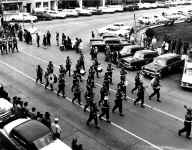
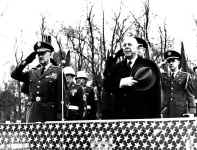
February 60 During this month, the Air Defense Board informed CONARC that the HAWK was unsuitable for field use and that no useful purpose could be served by continuing user service tests.
1 February 60 MG August Schomburg assumed command of AOMC.
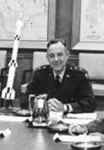
4 February 60 JUPITER Missile AM-30, the final JUPITER R&D missile, was successfully fired from Cape Canaveral at 1919 EST. Of the 29 missiles tested under this program, 22 were successful, 5 were partially successful, and only 2 were failures.
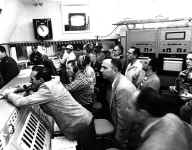
25 February 60 The Army fired the PERSHING missile for the first time. ABMA Missile Firing Laboratory personnel began R&D testing of the system by firing PERSHING Missile 105 from AMR at 1301 EST.
March 60 ARGMA completed the definitive objective study for the Field Army Ballistic Missile Defense System (FABMDS). Started in November 59, the study established the technical requirements for the FABMDS.
March 60 The first LACROSSE battalion was deployed to Europe.
7 March 60 AOMC gained the mission of providing technical assistance service on assigned items of materiel according to the provisions of AR 750-912 and as directed by OCO. Another change on 31 March eliminated the missions being transferred to NASA and references to JPL as well as spatial missiles and vehicles.
9 March 60 OTAC formally assigned the SHILLELAGH industrial and field service responsibility to ARGMA.
15 March 60 Final approval was obtained for the Army-NASA Transfer Plan. The SATURN project was also officially transferred from ABMA to the civilian agency.
15 March 60 REDSTONE Missile 2014 was successfully fired from WSMR, demonstrating for the first time that a missile-borne television system was feasible.
18 March 60 The U.S. HAWK Liaison Office, first established in Paris, France, on 26 October 59, was transferred from AOMC Headquarters to ARGMA. The organization was redesignated as the NATO-HAWK Liaison Office and was established as a separate mission staff element reporting directly to the ARGMA Commander.
23 March 60 Redstone Arsenal reactivated its Quick-Look communications network to support JUNO II Missile 19-C, fired from AMR at 0835 EST. The payload mission was not accomplished, and a preliminary evaluation was inconclusive. After providing reliable communications during the test, the network reverted to a standby status. NASA would be responsible for the network in the future.
31 March 60 The development contract for the MAULER system was awarded to Convair. The total development cost was expected to be about $108 million.
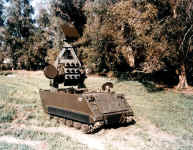
April 60 The first LACROSSE battalion deployed to Korea.
1 April 60 An Assistant Chief of Staff for Missile Intelligence joined AOMC Headquarters on this date.
13 April 60 In Paris, the five NATO countries that were going to produce HAWK (to equip 22 of their own battalions) signed a license agreement with Raytheon. The first of its kind, this license agreement was an outgrowth of the 1957 NATO Summit Conference at which the United States promised aid to western European nations to establish large-scale production of advanced weapons.
13 April 60 ABMA accepted PERSHING Missile 109 thereby completing the acceptance of all Group I missiles.
15 April 60 The physical transfer of JPL to NASA was almost completed by this date.
15 April 60 Upon discontinuing the AOMC Liaison Office at Sunnyvale, California, ABMA assumed liaison functions with the Navy on the POLARIS project. The intelligence and liaison functions that Sunnyvale performed for the Assistant Chief of Staff, Missile Intelligence, also transitioned to ABMA.
15 April 60 To reduce the size of AOMC Headquarters, the Commander ordered the Adjutant General to turn over the missions and functions of the AOMC Aviation Section to RSA. AOMC Headquarters, however, retained operational control of the section delegated to the Transportation Office Chief.
29 April 60 ABMA conducted the first static firing of all eight SATURN booster engines. The successful test lasted for 8.07 seconds.
2 May 60 The AOMC Commander gained the power to issue overseas temporary duty (TDY) orders covering those command employees who were visiting Army activities overseas conjointly with Field Service activities.
4 May 60 AOMC Headquarters authorized the RSA Commander to substitute a small boat, powered with twin motors of suitable horsepower and equipped with an appropriate radio receiving and transmitting unit, for the two J-boats used to patrol the arsenal's southern water boundary.

25 May 60 AOMC's part of Project PAINTED WARRIOR, which involved the overseas shipment of JUPITER missiles and GSE, was completed with the last shipment made on this day. Future operations for overseas delivery would be done from the Chrysler Corporation Missile Division at Warren, Michigan.
June 60 Early this month, AOMC established a new civilian Field Recruiting Office in Chicago, adding to those already set up in New York City, Dallas, and San Francisco.
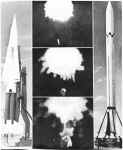
3 June 60 The CORPORAL became the first ballistic missile to be killed by a missile, after being tracked and shot down by a NIKE HERCULES at WSMR.
6 June 60 The AOMC Public Information Office transferred several functions to RSA, including community relations, troop information, Redstone Rocket publication activities, informational photographic activities, and coordination of tours/exhibits.
26 June 60 General Electric (GE) and Nord Aviation announced an agreement giving GE the right to build the SS-10 and SS-11 antitank guided missiles.
29 June 60 DOD announced that ATLAS Intercontinental Ballistic Missiles (ICBMs) would be used as targets to test the Army's NIKE ZEUS antimissile system. The original plan to test NIKE ZEUS against modified JUPITER IRBMs was dropped.
29 June 60 The Operations Division, Missile Intelligence, contracted with Aerojet General Corporation to complete a technical evaluation of the 150mm Soviet surface-to-surface missile, known to western powers as the SCUD. The study was completed on 18 May 61.
30 June 60 AOMC abolished the West Coast Field Office at Pasadena, California, and the NASA Liaison Office at Langley Field, Virginia. Personnel and manpower spaces reverted to the control of AOMC Headquarters.
July to December 60 AOMC and the Major Items Supply Management Agency (MISMA) reached an agreement on the transfer of ground handling equipment for the REDSTONE and PERSHING systems from ABMA to MISMA.
July to December 60 For the first time, fixed ceilings were placed on individual headquarters cost centers in order to operate within available funds.
1 July 60 Responsibility for directing and controlling the Ordnance Corps mission to train units in the PERSHING missile system was assigned to the Ordnance Training Command (OTC).
1 July 60 The JUNO II program was transferred to NASA.
1 July 60 Effective this date, AOMC/ABMA lost all of its space-related missions, along with about 4,000 civilian employees and $100 million worth of buildings and equipment at RSA and Cape Canaveral. Responsibility for both people and property was assumed by NASA's George C. Marshall Space Flight Center, which officially opened at Redstone Arsenal on this same date.
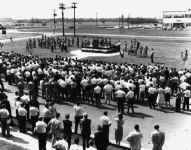
1 July 60 The Jet Propulsion Laboratory was phased out of the SERGEANT program, at which time the Sperry Utah Company assumed the role of prime contractor.
11 July 60 The first JUPITER launch position was turned over to the Italian Air Force. It became operational on 15 July 60.
26 July 60 PERSHING Missile 110, the sixth and last Group I missile in the R&D program, was successfully fired from AMR at 1100 EST. This was the first PERSHING fired at AMR from a transporter-erector-launcher (TEL) mounted on an XM474 trailer.
30 July 60 The first model of the PERSHING communications pack officially delivered to the Army arrived at the USA Electronic Proving Ground, Fort Huachuca, Arizona.
August 60 Although the technical assistance mission on guided missile systems was taken from Raritan Arsenal, New Jersey, and given to AOMC in March 60, the actual transfer of the 104 guided missile technicians from Raritan to Redstone took place during this month, with 97 going to ARGMA and 7 going to ABMA.
August 60 Responsibility for quality assurance efforts on the HONEST JOHN, LITTLEJOHN, and SERGEANT systems was transferred from ARGMA to ABMA.
August 60 The first known intercept of a Mach-3 missile by a missile took place at WSMR when a NIKE HERCULES tracked and destroyed another incoming NIKE HERCULES.
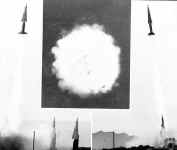
August 60 The CORPORAL weapon system went out of production during this month.
1 August 60 Effective this date, AOMC realigned its commodity management missions along two lines: air and space defense missile systems/battlefield guided weapons with post-launch control and pre-programmed/surface-to-surface missiles. These missions were divided between ARGMA and ABMA.
The latter agency assumed responsibility for former ARGMA projects such as SERGEANT, CORPORAL, LITTLEJOHN, HONEST JOHN, Missiles A & B, and the LAW. ARGMA retained responsibility for the NIKE ZEUS, NIKE HERCULES, HAWK, REDEYE, MAULER, LACROSSE, SHILLELAGH, SS-10/11, FABMDS, and target missile systems (excluding ZEUS targets).
15 August 60 R&D and OML, the latter ARGMA's oldest mission element, were integrated into a new organization designated as R&D Operations.
September 60 The first HAWK battalion was deployed to Korea.
September 60 The AOMC Commander lost the special channels of communication formerly authorized to him (i.e., direct access to the Secretary of the Army, Chief of Staff, and the Army Ballistic Missiles Committee).
September 60 A NIKE HERCULES shot down another NIKE HERCULES at an altitude of 19 miles, the highest known missile kill.
1 September 60 AOMC assumed the national procurement, inventory control, maintenance, industrial mobilization, and related support missions for target missile systems.
8 September 60 President Eisenhower officially dedicated NASA's George C. Marshall Space Flight Center at Redstone Arsenal.
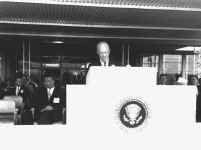
19 September 60 The Commander approved the AOMC calibration program, thus establishing a centralized program at AOMC with laboratories at RSA and WSMR.
29 September 60 The Phase I LITTLEJOHN program was terminated.
3 October 60 Effective this date, AOMC Headquarters transferred several transportation functions to RSA, including the scheduling of aircraft assigned to Redstone Arsenal and providing support for all aircraft landings and takeoffs at Redstone Army Airfield. RSA also assumed operational control of the AOMC Aviation Section.
4 October 60 Operation DRUMSTICK, using HAWK missiles against CORPORAL I missiles as targets, began on this date. The firings ended in January 61.
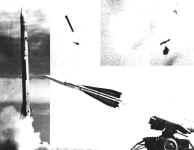
15 October 60 Building 5250, ARGMA's new headquarters, was formally dedicated. As part of the unique ribbon cutting ceremony for the new structure, AOMC Commander August Schomberg pressed a button which launched a model NIKE ZEUS missile. This model's interception of a model JUPITER missile caused a small explosion that severed the building's red ribbon. Activities at the Open House held in conjunction with the dedication ceremony included a tour of the new building, more than 90 missile contractor exhibits, and actual firings of small missiles at one of the ARGMA test areas.

20 October 60 JUPITER Missile 217 was fired from AMR in the first tactical missile test using tactical GSE. The missile hit a predetermined target 962.5 nautical miles downrange, achieving all primary and secondary missions.
31 October 60 AOMC Headquarters announced the transfer of all ballistic missile training responsibilities to the Ordnance Training Command.
November 60 A temporary annex for the Army commissary was established in Redstone Park. Although the annex initially was a limited item facility, the response to this service was so great that plans were finalized to enlarge it.
1 November 60 AOMC established the Missile and Rocket Inventory Control Center (MRICC) under ARGMA to provide common supply services to both ABMA and ARGMA. This center consolidated federal cataloging, automatic data processing (ADP) and electronic accounting machine (EAM) operations, and supply functions. The MRICC was later transferred to the RSA Commander on 26 March 61.
1 November 60 The first SHILLELAGH firing from a launcher was conducted.
December 60 In apparent recognition of its interest and potential in the DOD standardization program, AOMC received its first DOD-wide standardization assignment: responsibility for the standardization effort on systems for managing engineering data, particularly mechanized systems.
1 December 60 The 866th Technical Training Squadron (JUPITER), scheduled for deployment to Turkey, was activated at Redstone Arsenal.
19 December 60 MERCURY-REDSTONE 1 (MR-1) was launched but suffered a significant malfunction. Modified to correct MR-1 problems, MR-1A was successfully launched on this date, proving the system's operational capabilities in a space environment.
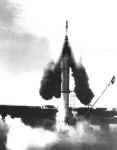
The ABMA/AOMC Era:
Introduction,
1956,
1957,
1958,
1959,
1960
1961,
1962
